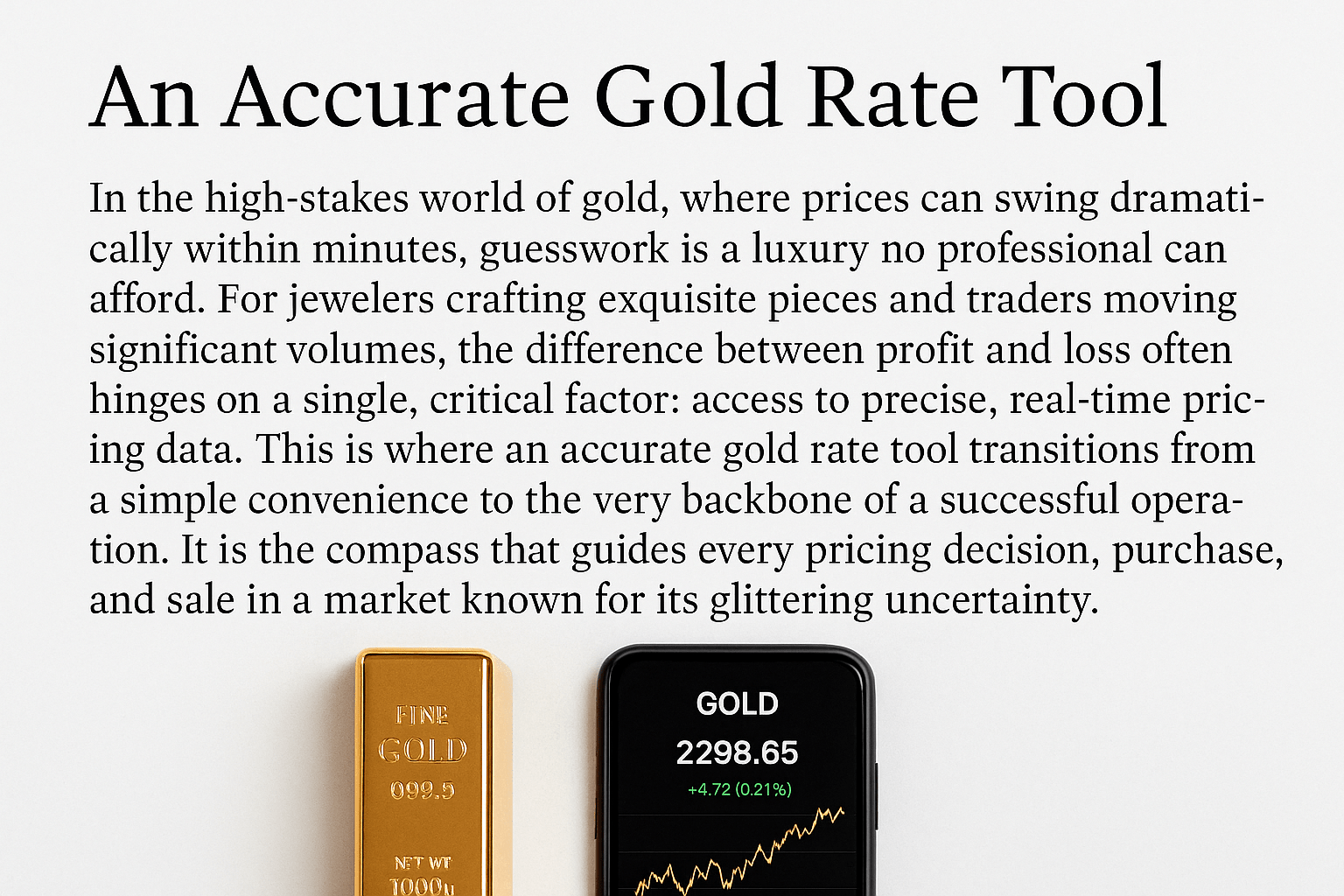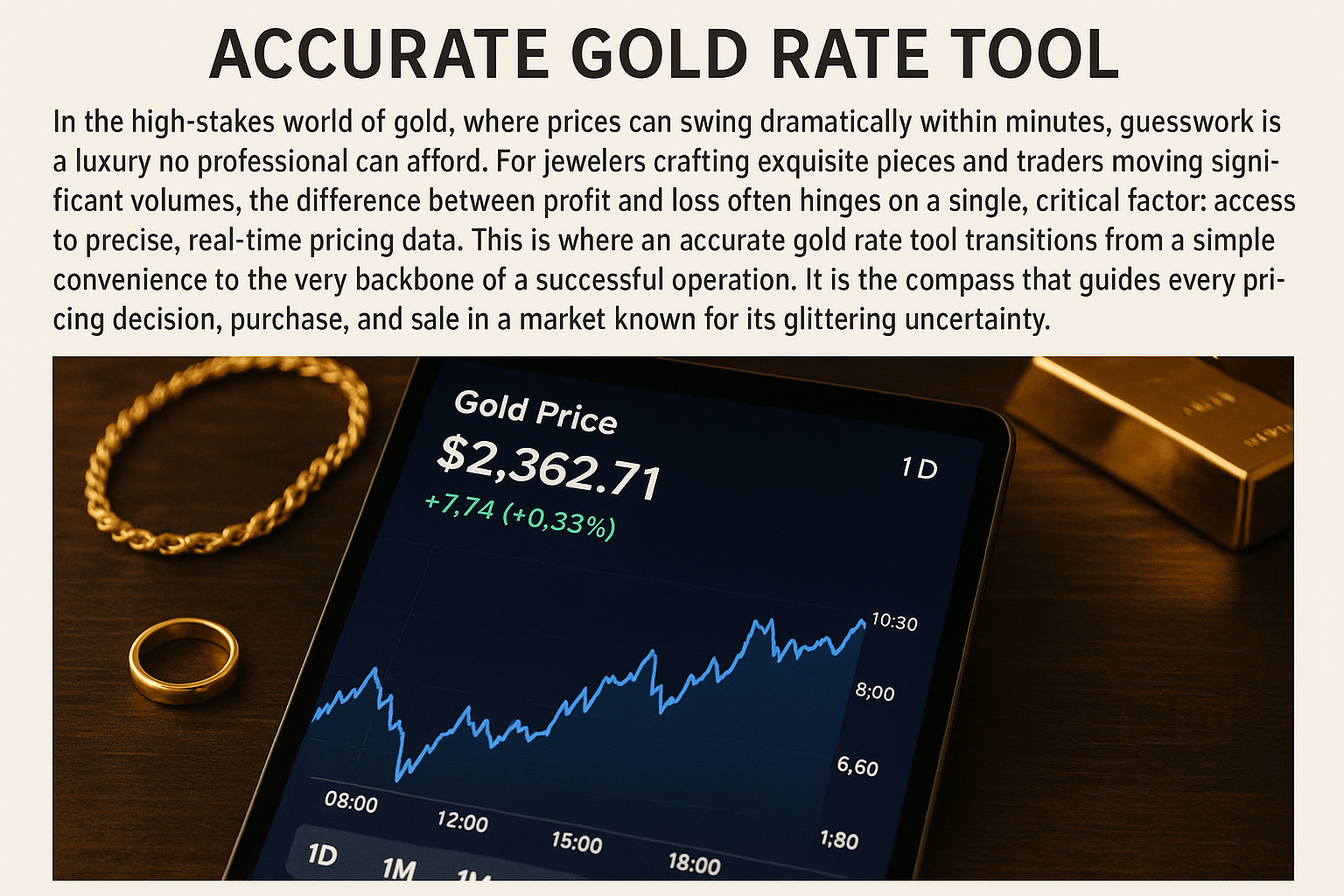In the high-stakes world of gold, where prices can (The Accurate Gold Rate Tool) swing dramatically within minutes, guesswork is a luxury no professional can afford. For jewelers crafting exquisite pieces and traders moving significant volumes, the difference between profit and loss often hinges on a single, critical factor: access to precise, real-time pricing data. This is where an accurate gold rate tool transitions from a simple convenience to the very backbone of a successful operation. It is the compass that guides every pricing decision, purchase, and sale in an market known for its glittering uncertainty.
Why “Approximate” Isn’t Good Enough: The Cost of Inaccuracy
Before delving into the tool itself, it’s crucial to understand the high cost of inaccuracy.
-
Eroded Profit Margins: A jeweler who underestimates the gold price when buying scrap or pricing a custom piece instantly erodes their margin. Conversely, overestimating it can lead to uncompetitive prices and lost sales.
-
Loss of Credibility: A trader or jeweler known for inconsistent or outdated pricing quickly loses the trust of their clients. In a business built on the intrinsic value of a asset, reputation is everything.
-
Operational Inefficiency: Manually checking rates from multiple sources, calculating premiums (making charges), and converting currencies is time-consuming and prone to human error. This takes valuable time away from core business activities like sales, design, and client relations.
An accurate gold rate tool automates and eliminates these risks, providing a single source of truth.

How Does a Gold Rate Tool Achieve Such Accuracy?
A best-in-class tool is far more than a simple number on a screen. It’s a sophisticated system that aggregates and processes data from global sources. Here’s a simplified breakdown:
-
Data Aggregation: The tool pulls live data from major international bullion exchanges like the LBMA (London Bullion Market Association), COMEX (Commodity Exchange Inc.) in New York, and key domestic exchanges like MCX (Multi Commodity Exchange of India). This ensures a globally recognized benchmark.
-
Currency Conversion: Since gold is primarily traded in US Dollars, the tool instantly converts the price into the local currency (e.g., Euros, Indian Rupees, Dirhams) using real-time forex rates.
-
Premium Calculation: This is where it gets specific to the jewelry trade. The tool allows users to input variables like:
-
Purity (Karat): The price for 24k (999 purity) gold is different from 22k (916 purity), 18k, etc.
-
Weight: Precisely calculating the price for grams, ounces, Tolas, or sovereigns.
-
Making Charges: The tool can separate the cost of the raw gold from the artistry (labor, design, stone-setting), which is crucial for transparent customer pricing.
-
-
Display: The final, calculated rate is displayed in a clear, easy-to-read interface, often updated every few seconds.
Key Features to Look for in a Top-Tier Gold Rate Tool
Not all tools are created equal. Professionals should seek out platforms that offer:
-
Real-Time Updates: Prices should refresh at least every minute. In fast-moving markets, a 15-minute delay can be catastrophic.
-
Multi-Currency and Unit Support: The ability to switch between grams, ounces, kilos, Tolas, and Baht, and view prices in relevant currencies is essential for businesses with international clients or suppliers.
-
Historical Charts and Data: The ability to view price trends over days, months, and years is vital for making informed buying and selling decisions.
-
Customizable Calculators: A built-in calculator that lets you quickly price items based on purity, weight, and making charges is a non-negotiable feature for jewelers.
-
Mobile Accessibility: A dedicated mobile app or a responsive website ensures you can check rates and make calculations on the go, from the workshop or the market.
-
Reliable Data Sources: The provider should be transparent about where their data is sourced from (e.g., LBMA, MCX). Reputable sources lend credibility to the tool.
-
Alerts and Notifications: SMS or push notifications for when gold crosses a certain price threshold can help traders capitalize on market movements.

A Case Study in Confidence: The Modern Jeweler’s Workflow
Imagine Sarah, a jeweler who has just received a request for a custom 22k gold necklace. A customer has provided old gold scrap to be melted down and wants to know the final cost.
-
The Old Way: Sarah would check a website, note the approximate 24k price. She would then manually calculate the value for 22k, weigh the customer’s scrap, subtract a refining fee, and then add her making charges. The process is slow and leaves room for error at every step.
-
The New Way with an Accurate Gold Rate Tool: Sarah opens her app. She:
-
Sees the live, LBMA-sourced 24k price per gram.
-
Uses the in-app calculator, selects “22k” from a dropdown menu. The app automatically applies the correct purity multiplier (e.g., 22/24ths).
-
Inputs the weight of the customer’s scrap. The app instantly shows the exact melt value.
-
Inputs her standard making charge (either a flat rate or a percentage). The app generates a final, itemized quote in seconds.
-
She can show the customer the transparent breakdown: “Here is the value of your gold at today’s exact rate, and here is the cost of my craftsmanship.” This builds immense trust and positions her as a professional.
Conclusion: More Than a Number, It’s Your Business Partner
In the final analysis, an accurate gold rate tool is not merely a widget on a website; it is a strategic business partner. It empowers jewelers and traders with the confidence to make swift, informed, and profitable decisions. It safeguards margins, enhances professionalism, and builds lasting trust with a clientele that values transparency. In the timeless dance of the gold trade, where beauty and value are inextricably linked, this modern tool is the essential rhythm every professional needs to follow.
Frequently Asked Questions (FAQs)
Q1: How often do the rates update in a real-time gold tool?
The best tools update their prices every 60 seconds or even more frequently, reflecting the near-live ticker from major global exchanges.
Q2: Is the price shown for 24k gold, and how do I calculate for 18k or 14k?
Yes, the baseline price is almost always for 24k (999 purity) gold. To calculate for lower karats, you apply a purity ratio. For example, for 18k gold, you would calculate: (18/24) * Live 24k Price. A good gold rate tool will have a built-in calculator that does this automatically.
Q3: Why is the price I see on the tool different from the price I get at my local jeweler?
The tool shows the spot price—the raw, wholesale price of pure gold. Your local jeweler adds a premium to this price. This premium covers their business costs (rent, staff, security), craftsmanship (making charges), design, and a modest profit margin. A transparent jeweler will happily break down this premium for you.
Q4: Are free gold rate tools accurate enough for professional use?
While many free tools use reliable data, professionals should invest in or subscribe to tools designed specifically for the trade. These professional-grade tools offer faster updates, more advanced calculators, historical data, and ad-free reliability that free versions often lack.
Q5: Can these tools help with buying gold for investment?
Absolutely. While they are essential for jewelers, the real-time data and historical charts are incredibly valuable for investors and traders looking to track market trends and time their entry and exit points in gold ETFs, bullion, or digital gold.
Disclaimer: This article is for educational and informational purposes only. The gold market is volatile, and prices can change rapidly. The information provided here should not be construed as financial or investment advice. While we strive to provide accurate and timely information, we do not guarantee the accuracy or completeness of any data presented. You should conduct your own research and consult with a qualified financial advisor before making any business or investment decisions. If you have any concerns about the content of this post, please visit our DMCA page for guidance on the removal process.
